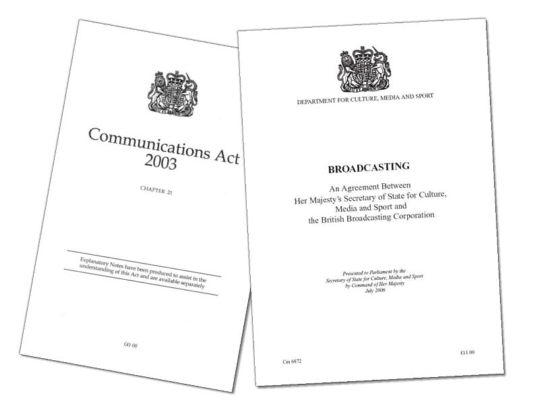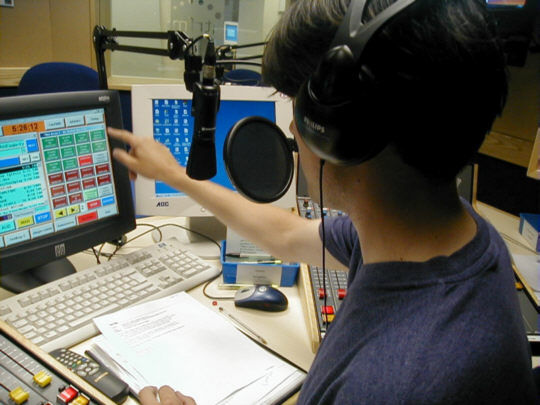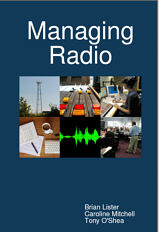
Brian Lister is a senior radio industry consultant and visiting lecturer in radio management at the University of Sunderland, UK. He is a well known commercial radio manager of many years standing, a consultant and trainer who has also aided numerous groups to gain commercial and community radio licences.

Caroline Mitchell is Senior Lecturer in Radio at the University of Sunderland and a trainer and consultant in community media. She was previously Head of Radio at the University where she established the MA in Radio (Production and Management). She has produced research publications in the area of radio studies, women and radio and community radio and has over 20 years experience of advising community radio groups in the area of radio training and setting up participatory radio station structures and programming.

Dr. Anthony O'Shea is Senior Lecturer in Organisational Studies and Organisational Theory, University of Sunderland, UK. He has published widely in the area of organisational studies, organisational theory and critical management studies and collaborated on conference papers in radio management.
This publication comes out of a collaborative project between the authors who have worked together on radio management courses for Sunderland's successful MA in Radio (Production and Management). The publication aims to be both a useful text for students studying the theory and practice of managing radio stations and to provide contextual and critical essays from leading academics and radio to broaden the reader's understanding of the area. Finally there are short case studies based on empirical research that exemplify different station structures and management approaches. It mainly concentrates on station management in the BBC local, commercial and community sectors - it is not our intention to focus very much on BBC network management.
CONTENTS
Section 1 - Theory and Background

1.1 Introduction
We introduce the changing and complicated environment of radio in terms of technological, social, economic and political forces that affect it. We provide detail on both the size and nature of the environment, the radio audience and the changing nature of regulation, competition and the demands of the industry and the audience whilst focusing particularly on technological advances in the industry. We argue that these complicated and rapid changes that beset radio place new demands on radio management and managers and that they need to respond appropriately in order to meet these and maintain the trust of their audiences. From this we move on to outline why there is a need for this book and the audience that it is aimed at and provide detail on the structure and content of the remainder of this publication.
1.2 Radio industry overview
This section maps the UK radio industry and the regulatory framework for radio. It will present an overview of the different sectors for radio: BBC, commercial and community radio (including hospital and student stations) and the small but growing sector of independent production companies and web and podcasting operators. At the beginning of the second millennium the very use of the term 'radio' has become debatable because it is now available on so many platforms other than that provided by the traditional transmitter-receiver model. This section will survey these platforms including Digital Audio Broadcasting (DAB) Digital Multimedia Broadcasting through mobile devices (DMB) web radio and podcasting.
1.3 Working in radio management
We look at the scope of employment in UK radio. What has to be managed and who does the managing? Taking typical jobs in BBC, commercial and community radio we outline work areas that need to be managed: Programming, news and sport, sales, marketing, commercial production, sales traffic, engineering, compliance, liaison with outside bodies, house maintenance, accounts and finance, administration and human resources. We look at job areas specific to the new community radio sector - volunteer management and community development and training.
1.4 Core concepts of radio station management
We explore core concepts of radio station management from the perspective of the radio manager, informed by relevant research and practice gleaned from business and management studies We show how awareness of 'brand values' and 'mission statements' are important to any station. We look at different management styles, the importance of the winning team, leadership and vision. We discuss the need for creative people in station management and the challenges of managing creative people and processes and the challenge of multi-tasking within small-scale station management. We ask whether different sectors and platforms in radio require different management practices and using the example of managing radio presenters whether different parts of the workforce require different management styles.
Section 2 - Practice

2.1 Knowing and researching your audience
We outline the principles and techniques of audience research including qualitative and quantitative methods and techniques and how to understand and interpret Rajar (Radio Joint Audience Research Limited) surveys. We look at some critical perspectives on audience research methodologies and some of the problems of audience measurement for small-scale and community stations. Finally we discuss what radio managers can learn from media academics.
2.2 Station and organizational structures
In this chapter we will look at the structures of different radio stations. We will consider how and why a radio station may be considered legally as a single, cohesive organisation before moving to outline different types of structure within the radio industry. We will outline the roles of management and staff in radio stations before providing two different examples of organisational structure from community and commercial radio. What we will argue is that in many radio stations people, and particularly managers, often assume multiple roles. Furthermore we will also argue that community radio stations often have structures that are less based on a classical hierarchy and more on an integrative and consensual one based on shared values. We will discuss how commercial radio stations may have both a local hierarchy but may also be part of a wider national, or international, structure that includes other group companies and service providers outside the parent company.
2.3 Financial management, sales and fundraising
There is no doubt that strong financial management of a radio station is paramount to its survival. BBC services have to show that they use their licence fee income effectively, community stations need to generate and manage income from different sources to meet their aims and maintain independence and in commercial radio a primary objective of the station manager is to operate in a manner that generates the most profit. In this chapter we will first look at the importance of fixed and variable costs in radio management and how these can impact on the delivery model of the station. We will then consider the importance of costs and cash flow, particularly with regard to establishing a new radio station before moving on to consider how income and costs may be estimated and the potential sources of revenue for a radio station. We then move on to consider how advertising, sponsorship and subscription are forms of income alongside license fees and how community stations face a particularly demanding job raising money for training and community participation on top of the usual station running costs.
2.4 Applying for a licence
We look at the various forms of radio broadcast licenses that exist in the UK. We will detail the content of both a commercial and a community radio license application and also discuss the advent of licenses for new broadcast services such as DAB.
2.5 Managing programme content
2.6 Managing music programming
2.7 Managing news and phone-ins
We consider three areas of managing programme content: firstly, techniques for designing and managing programmes to keep the audience listening; secondly, managing different aspects of music and programming, and; thirdly, managing two specialist areas of speech - radio news and phone-ins.
2.8 Station imaging and marketing
We explore how a radio station may market and promote itself. This includes both on-air marketing via station identity, jingles and call signs, and off-air marketing including research, SWOT analysis and press coverage. We end with a consideration of how publicity may be managed to promote media coverage for different types of radio stations.
2.9 Legal Issues for Managers
A radio station is generally constituted as a private company or a department of a larger company and is subject to all the laws and regulations governing any such body. In handling the specific challenges of public broadcasting it is all too easy for the manager to lose sight of general legal requirements in fields such as employment, health and safety and taxation. While in no way wishing to minimise the importance of such issues for the radio manager, up-to-date information on these areas of legislation is widely available and we will here concentrate on matters more specific to broadcasting.
2.10 Managing People
We consider how people may be managed in a radio station. In particular we will focus on the selection and retention of personnel (both paid staff and volunteers) and outline practical means to recruit them and how a station manager is affected by legislation. Finally we look at several examples of radio training initiatives relating to radio management and developing skills within in the community radio sector.
2.11 Managing resources and technology
Historically, many senior radio managers have feigned ignorance of, and abdicated responsibility for, the technical aspects of getting programmes to listeners. Although it is not necessary for the manager to have a component-level knowledge of the technology behind today's digital media, a basic understanding of the capabilities and potential of the new technologies provides a real advantage for maximising the performance of any mass medium. Here we will cover the broad issues that most often cause concern or confusion for the non-technical manager.
2.12 Monitoring, review and evaluation
In this section we will consider how the performance of a radio station may be managed. We will look at how financial and operational performance may be monitored, reviewed and evaluated and, with respect to operational performance consider particularly how staff may be managed in an appropriate manner. The section will close by considering how a successful station may maintain its performance, how we might turn around the performance of an ailing one and how community radio can contribute to new forms of impact assessment and measurement.
Section 3 - Case Studies

3.1 Sunderland local radio
Brian Lister looks at how a local radio service has developed and changed and relates these to various concepts within this book. This detailed case study of the development of local radio in Sunderland demonstrates how these concepts influenced and affected the development of a radio station across nearly twenty years and provides thought provoking insights in to the issues surrounding managing radio. Sunderland's local radio service has undergone a great number of significant transformations since its launch in 1990, changing its name twice under six owners of radically different backgrounds and motivation from a community organisation to major commercial radio groups. The management styles and structures of the station have been as varied, responding to a range of commercial, managerial and regulatory challenges which might be seen as a reflection of the issues facing British local radio as a whole.
3.2 Bradford Community Broadcasting
Caroline Mitchell offers Bradford Community Broadcasting (BCB) as an example of good practice in UK community radio. Bradford is a large, culturally diverse city of around 280,000 residents that made its former wealth through the textiles industry. BCB broadcasts to a five kilometre radius from Bradford city centre and although it was finally awarded a community licence to broadcast from January 2006 it has broadcast full- time since 2002 under the Access Radio pilot scheme and between 1992 and 2002 using around 30 different RSL licences on both AM and FM. The station received the Radio Academy Nations and Regions Award for the North East and Yorkshire region in December 2003. Since 1992 the station has grown from a RSL run on volunteer effort to a thriving station with nine paid staff and at least 200 volunteers. It has state of the art studios and offices in the centre of Bradford.
3.3 'The Joy of Six' - BBC 6 Music
Jo Tyler, a Producer who worked on the development and launch of BBC 6 Music, focuses on the launch of BBC 6 Music, one of a 'suite' of radio stations created by the BBC to substantiate the corporation's move into digital radio. These stations evolved alongside significant developments in multi-platform and interactive media, including websites and facilities for interaction with an audience who was becoming more familiar with use of media technologies. The launch of 6 Music was significant in many ways: it was the BBC's first new music station since the re-organisation of BBC Radio 3 in 1970 and; it was the first to utilise the extensive BBC music session archive, derived primarily from BBC Radio 1 recorded sessions. As a station that also had to cater for a broader and more diverse audience, 6 Music provided challenges for managers in terms of management of the cross platform content. Focusing on the lead up period to the launch of 6 Music in 2002, this case study provides a brief historical background to the planning of 6 Music, outlining issues raised from the convergence of the BBC media environment. It explores the production techniques and formats adopted when launching a new station whose audience interact on many platforms.

Go to main page